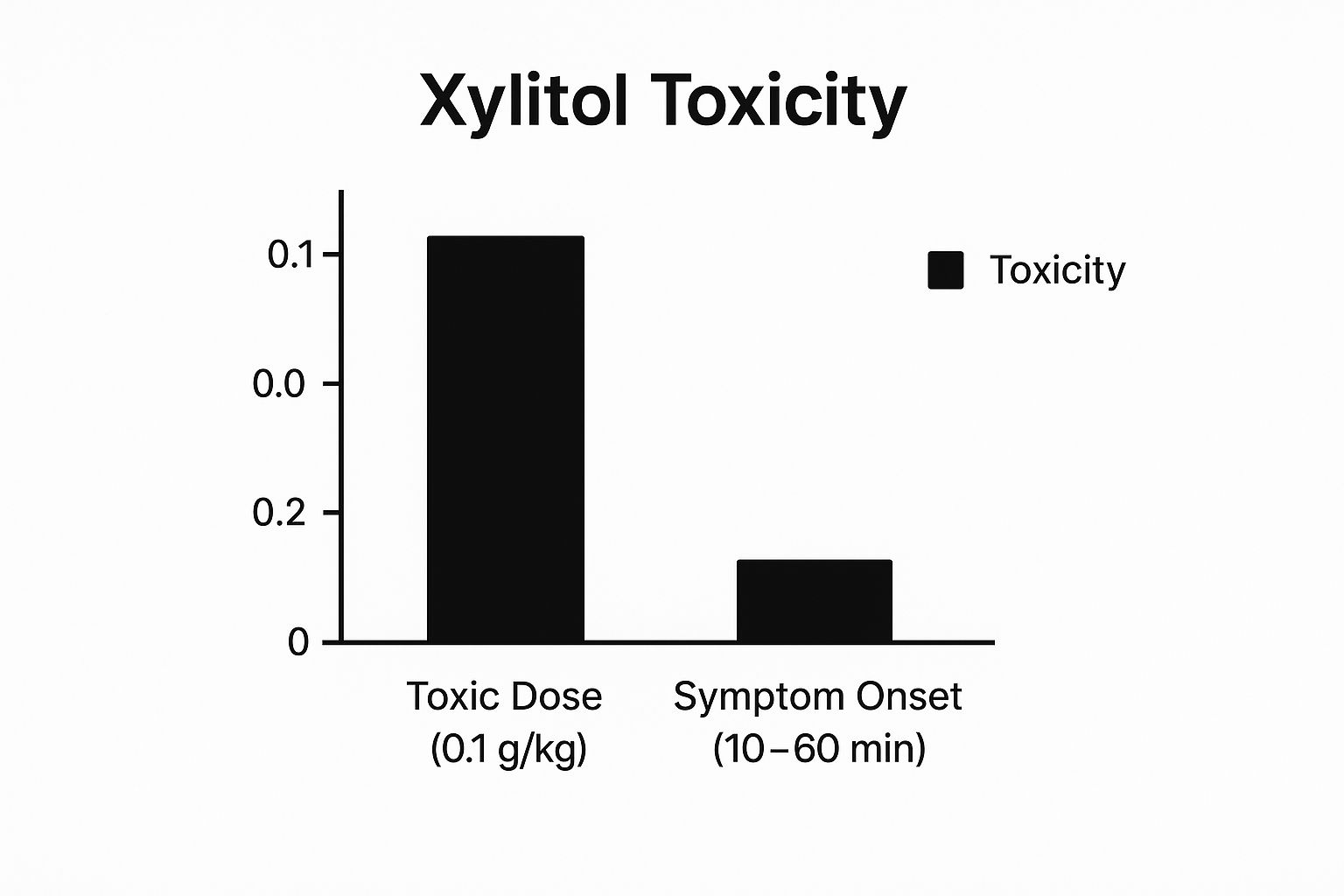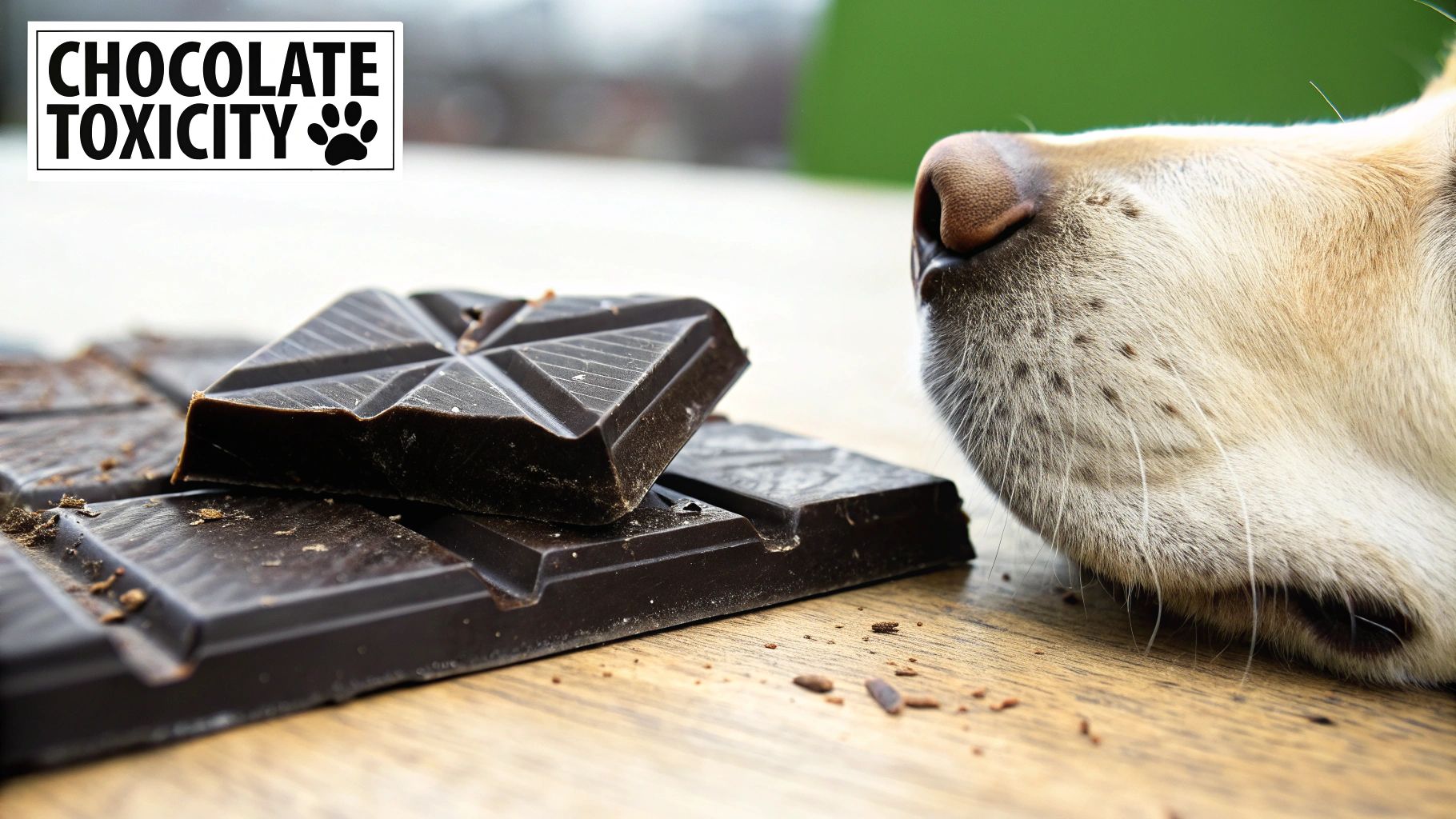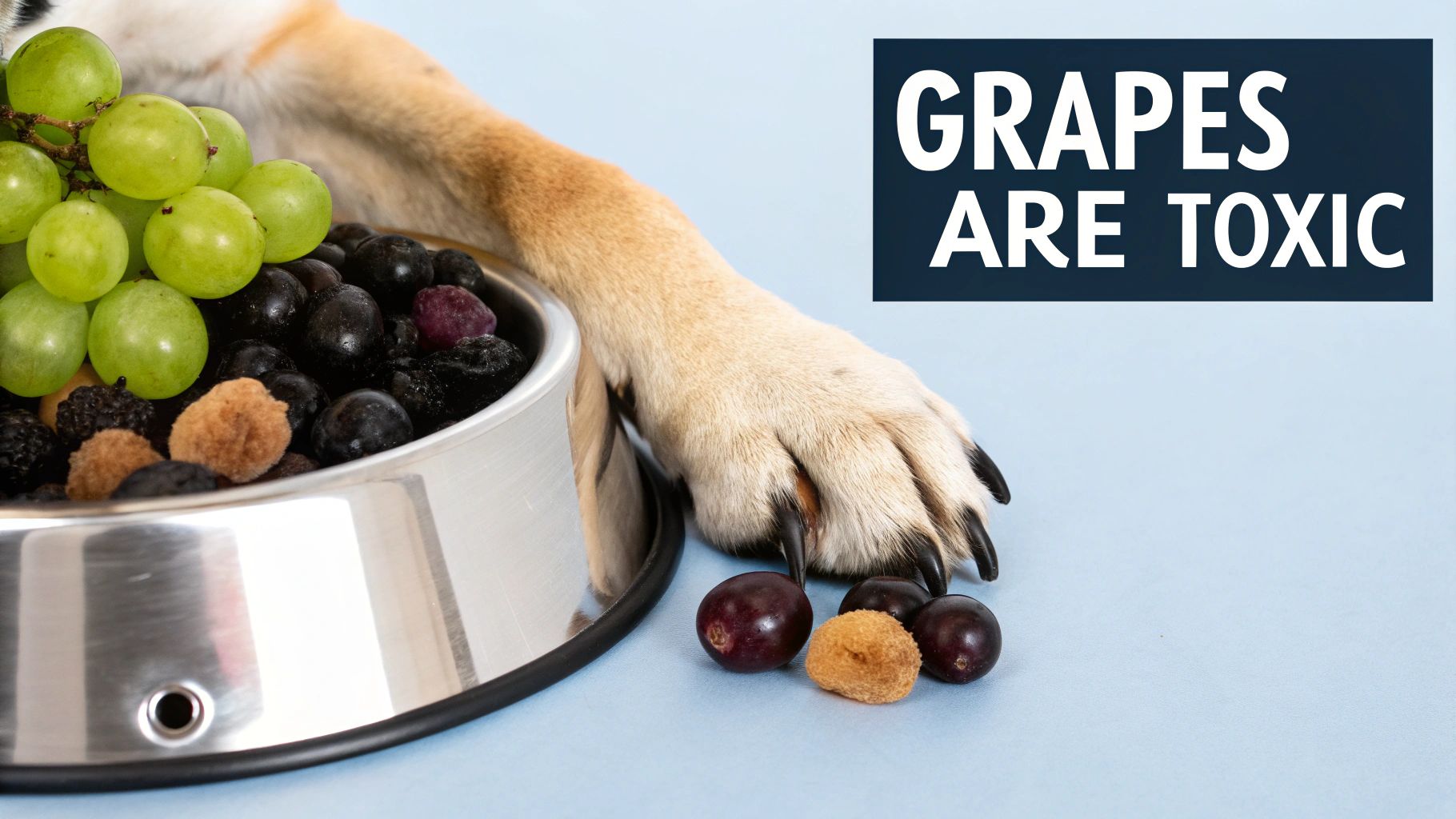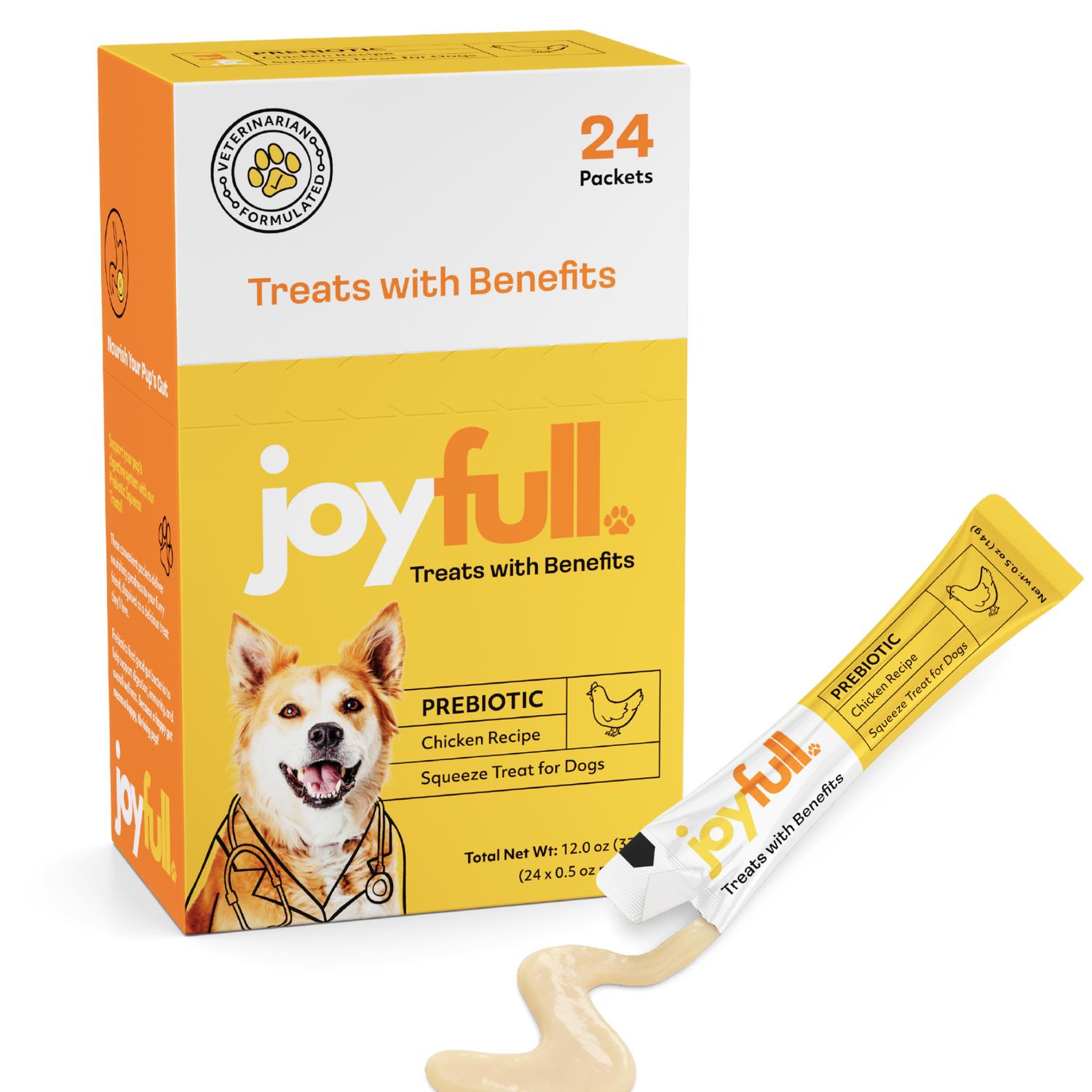
Top 8 Ingredients to Avoid in Dog Treats in 2025
As devoted pet parents, we love rewarding our furry family members. But have you ever paused to read the tiny print on that treat bag? Hidden within seemingly harmless snacks are ingredients that can pose serious health risks, from immediate toxic reactions to long-term chronic illness. Many popular treats are packed with fillers, artificial additives, and even substances that are outright toxic to canines, turning a simple reward into a potential health hazard.
This isn't about fear-mongering; it's about empowerment. Knowing which ingredients to avoid in dog treats is one of the most crucial responsibilities of a pet owner. Making informed, health-conscious choices ensures every treat you give contributes to your dog's well-being, not their detriment.
This guide is designed to be your go-to resource. We will walk you through the most critical ingredients to steer clear of, explaining the science behind the danger in clear, simple terms. For each item on our list, you'll learn not just what to avoid, but why it's harmful and what to look for instead. We'll equip you with the knowledge to confidently scan any label and select snacks that keep those tails wagging for years to come.
1. Xylitol
Among the most critical ingredients to avoid in dog treats is xylitol, an artificial sweetener that is harmless to humans but extremely toxic to dogs. While it's a popular sugar substitute in many "sugar-free" human products, it poses a severe and immediate threat to canine health.
When a dog ingests xylitol, it is rapidly absorbed into the bloodstream. This triggers a potent release of insulin from the pancreas, causing a drastic and sudden drop in blood sugar levels (hypoglycemia). This life-threatening reaction can occur within 10 to 60 minutes of consumption.
The Science of Xylitol Toxicity
The danger of xylitol lies in how a dog's body processes it compared to a human's. In people, xylitol doesn't stimulate insulin release. In dogs, the body mistakes it for real sugar, leading to the massive insulin spike that causes severe hypoglycemia. At higher doses, xylitol can also cause acute liver failure, which is often fatal.
The following infographic illustrates the small dose required to cause toxicity and the rapid onset of symptoms.

This bar chart highlights the urgency of the situation, showing that symptoms can appear in as little as ten minutes from a very small dose.
Actionable Tips for Pet Owners
Keeping your dog safe from xylitol poisoning requires constant vigilance and awareness of where this ingredient hides.
- Read Every Label: Always check the ingredient list on products, especially peanut butter, baked goods, and anything labeled "sugar-free" or "diabetic-friendly."
- Secure Dangerous Items: Store all xylitol-containing products like gum, mints, toothpaste, and certain medications far out of your dog's reach. A closed pantry or high cabinet is essential.
- Choose Safe Alternatives: When sharing peanut butter as a treat, opt for brands confirmed to be xylitol-free, such as Skippy Natural or Smucker's Natural. Better yet, choose peanut butter made specifically for dogs.
- Know the Signs: Be aware of the symptoms of xylitol poisoning: vomiting, weakness, staggering, collapse, and seizures. If you suspect your dog has ingested xylitol, it is a medical emergency requiring immediate veterinary care.
2. Chocolate (Theobromine and Caffeine)
A widely known toxin for dogs, chocolate contains substances called methylxanthines, specifically theobromine and caffeine, making it one of the most important ingredients to avoid in dog treats. While a beloved treat for humans, these compounds are poisonous to dogs because they metabolize them much more slowly, allowing toxic levels to build up in their system.
The danger of chocolate depends entirely on its type and the amount ingested. Darker, more bitter chocolates contain higher concentrations of theobromine and pose a much greater risk. Even small amounts can cause significant health problems, making any chocolate-flavored product a hazard.

Why Chocolate Is Toxic
Theobromine and caffeine act as stimulants, primarily affecting a dog's central nervous system, cardiovascular system, and respiratory system. Unlike humans, who can process these compounds efficiently, dogs lack the necessary enzymes to break them down quickly. This slow metabolism leads to overstimulation, which can cause severe and potentially fatal symptoms.
The video below offers a veterinarian's perspective on the specific dangers and what to do in an emergency.
The concentration of theobromine varies drastically between chocolate types:
- Baking Chocolate: Highest risk, with up to 450mg of theobromine per ounce.
- Dark Chocolate: High risk, containing around 150mg per ounce.
- Milk Chocolate: Moderate risk, with about 50mg per ounce.
- White Chocolate: Minimal risk, as it contains negligible amounts of theobromine.
Actionable Tips for Pet Owners
Preventing chocolate toxicity involves securing your home and knowing what to do if an accident occurs.
- Secure All Chocolate: Store chocolate bars, cocoa powder, brownies, and other treats in high cabinets or sealed containers completely out of your dog's reach.
- Be Vigilant During Holidays: Be extra cautious during holidays like Halloween, Christmas, and Easter, when chocolate is more abundant and accessible in the home.
- Use Safe Alternatives: If you want to give your dog a chocolate-like treat, use carob. It's a safe, dog-friendly alternative that looks and tastes similar but contains no theobromine or caffeine.
- Know What to Do: If you suspect your dog has eaten chocolate, immediately contact your veterinarian or the Pet Poison Helpline. Note the type of chocolate, the estimated amount consumed, and your dog's weight to help them assess the risk.
3. Grapes and Raisins
Another surprising yet highly dangerous item on the list of ingredients to avoid in dog treats is grapes and their dried form, raisins. While these fruits are a healthy snack for humans, they are severely toxic to dogs and can cause sudden, acute kidney failure.
The exact substance within grapes that causes this toxic reaction is still unknown, which makes it particularly insidious. Furthermore, the toxicity isn't dose-dependent in a predictable way; some dogs can become sick after eating just a single grape, while others may show no signs. Due to this unpredictability, all grapes and raisins should be considered a major threat.

This image of fresh grapes and raisins serves as a visual reminder of the common forms of this dangerous fruit, both of which pose a significant risk to canine health.
The Science of Grape Toxicity
When a dog ingests grapes or raisins, the unidentified toxin can lead to severe damage to the kidneys. The process can begin quickly, with initial symptoms like vomiting and lethargy appearing within hours. If left untreated, this can progress to complete kidney shutdown, which is often fatal.
The idiosyncratic nature of this toxicity means there is no established safe amount. Any ingestion, no matter how small, should be treated as a potential emergency. The risk applies to all types of grapes-red, green, seeded, and seedless-as well as products containing them, such as grape juice and baked goods.
Actionable Tips for Pet Owners
Preventing grape and raisin poisoning involves careful management of your home environment and educating everyone in the household.
- Secure All Grape Products: Keep fresh grapes, raisins, trail mix, and baked goods like raisin bread or oatmeal raisin cookies stored safely in high cupboards or locked pantries where your dog cannot access them.
- Practice Kitchen Safety: Be mindful of dropped food when cooking or snacking. A single grape rolling off the counter can be quickly snatched up by a curious dog.
- Educate Everyone: Ensure that all family members, especially children, and any house guests understand that grapes and raisins are not safe treats for dogs.
- Know the Signs: Watch for early symptoms of toxicity, including vomiting, diarrhea, loss of appetite, lethargy, and abdominal pain. If you suspect your dog has eaten any grapes or raisins, contact your veterinarian or an emergency pet hospital immediately.
4. Onions and Garlic (Allium Family)
Another group of common kitchen staples on the list of ingredients to avoid in dog treats is the Allium family, which includes onions, garlic, chives, and leeks. While these ingredients add flavor to human food, they contain compounds that are toxic to dogs, whether they are raw, cooked, or in powdered form.
When a dog consumes members of the Allium family, the thiosulfates they contain cause oxidative damage to red blood cells. This damage leads to the cells rupturing, a serious condition known as hemolytic anemia. The effects can be cumulative, meaning small, repeated exposures can be just as dangerous as a single large dose.
The Science of Allium Toxicity
The thiosulfates in onions and garlic interfere with the normal function of a dog's red blood cells, which are responsible for carrying oxygen throughout the body. The damaged cells can no longer transport oxygen efficiently, leading to symptoms like weakness, lethargy, and pale gums. Garlic is considered approximately five times more potent than onions in its toxicity to dogs.
The danger is often hidden, as onion and garlic powder are frequently used as flavor enhancers in a wide range of human foods, from broths and sauces to baby food and seasoned meats, making accidental ingestion a significant risk.
Actionable Tips for Pet Owners
Preventing Allium toxicity requires careful attention to the ingredients in both commercial and homemade foods.
- Scrutinize Ingredient Lists: Always check the labels on broths, sauces, and pre-packaged foods for "onion powder" or "garlic powder," especially if you plan to use them in homemade treats.
- Ban Allium-Seasoned Scraps: Never feed your dog table scraps from meals seasoned with onions or garlic, such as pasta sauce, seasoned meats, or casseroles.
- Check Baby Food Carefully: Some pet owners use baby food for sick pets or as a treat. Be vigilant, as many varieties, particularly savory meat flavors, contain onion powder.
- Recognize the Symptoms: Watch for signs of anemia, which may not appear for a few days. Key symptoms include lethargy, pale gums, rapid breathing, weakness, and reddish or brown urine. Contact your vet immediately if you notice these signs.
5. Macadamia Nuts
Another surprising yet dangerous item on the list of ingredients to avoid in dog treats is the macadamia nut. While a buttery and delicious snack for humans, these nuts are uniquely toxic to dogs, causing a distressing but typically non-fatal syndrome that pet owners should be aware of.
When a dog consumes macadamia nuts, it can lead to a condition known as macadamia nut toxicosis. Symptoms usually appear within 12 hours of ingestion and can cause significant discomfort for your pet. Even a small amount of macadamia nuts can be enough to trigger a reaction in sensitive dogs.
The Science of Macadamia Nut Toxicity
The specific compound within macadamia nuts that causes this toxic reaction in dogs is still unknown to scientists. However, the effects are well-documented and consistent. Ingestion leads to a temporary, non-fatal poisoning that affects the dog's nervous system, muscles, and digestive tract.
The reaction is characterized by weakness, especially in the hind legs, which can progress to an inability to stand. While frightening for both the pet and owner, most dogs recover fully within 24 to 48 hours with supportive care. The good news is that fatalities from macadamia nut ingestion are extremely rare.
Actionable Tips for Pet Owners
Preventing macadamia nut toxicosis is a matter of diligence and careful management of human foods in your home.
- Check Labels on Baked Goods: Be extra cautious with cookies, brownies, and breads, especially white chocolate macadamia nut varieties. Always read the ingredient list before sharing any human treat.
- Secure Kitchen and Pantry: Store macadamia nuts and products containing them, like trail mixes, in sealed containers in high cabinets or pantries that your dog cannot access.
- Recognize the Symptoms: Watch for signs like weakness or paralysis in the back legs, lethargy, vomiting, tremors, and an elevated body temperature (hyperthermia).
- Contact Your Vet Immediately: If you suspect your dog has eaten macadamia nuts, call your veterinarian or an animal poison control center right away. While the condition is rarely fatal, your vet can provide guidance on supportive care to keep your dog comfortable.
6. Artificial Preservatives (BHA, BHT, Ethoxyquin)
Among the most controversial ingredients to avoid in dog treats are synthetic preservatives like butylated hydroxyanisole (BHA), butylated hydroxytoluene (BHT), and ethoxyquin. These chemicals are added to prevent fats from going rancid, dramatically extending the shelf life of many commercial pet foods and treats. While effective for preservation, their long-term safety for canine health is a significant concern.
These artificial preservatives work by inhibiting oxidation in fats and oils. However, studies have linked long-term consumption of BHA, BHT, and ethoxyquin to a range of serious health issues, including liver damage, allergic reactions, and even cancer. Their presence is often a red flag for lower-quality, highly processed treats where shelf stability is prioritized over nutritional integrity.
The Science of Synthetic Preservatives
The controversy surrounding these chemicals stems from their potential to cause cellular damage over time. BHA and BHT are recognized as potential carcinogens, and while regulatory bodies permit them in small amounts, the cumulative effect of daily exposure through treats and food is a legitimate concern for pet owners. Ethoxyquin, originally developed as a pesticide, has been largely phased out of human foods but is still permitted in some pet food products.
The primary function of these chemicals is to keep products from spoiling on a shelf for months or even years. This convenience comes at a potential cost to your dog's long-term health, making them a key ingredient to identify and avoid.
Actionable Tips for Pet Owners
Choosing safer, naturally preserved treats is a straightforward way to protect your dog from the risks associated with these synthetic chemicals.
- Look for Natural Alternatives: Opt for treats preserved with natural substances like tocopherols (vitamin E), ascorbic acid (vitamin C), or rosemary extract. These are effective and safe for canine consumption.
- Read the Ingredient List: Always check the label for "BHA," "BHT," or "ethoxyquin." Also, look for positive statements such as "naturally preserved" or "no artificial preservatives."
- Choose Shorter Shelf-Life Products: Treats without synthetic preservatives won't last as long. A shorter expiration date is often a good sign that the product uses fewer or no artificial additives.
- Store Treats Properly: To maintain the freshness of naturally preserved treats, store them in a cool, dry place in an airtight container, and use them before the expiration date. By doing so, you can ensure you are providing some of the healthiest treats for dogs available.
7. High Salt Content
Another crucial entry on the list of ingredients to avoid in dog treats is excessive sodium. While a small amount of salt is essential for a dog's bodily functions, many commercial treats and human snacks contain far too much, posing significant health risks from dehydration and salt poisoning to long-term heart and kidney problems.
Dogs have a much lower sodium requirement than humans. When they consume too much salt, their bodies attempt to balance it by increasing thirst and urination. If this imbalance becomes severe or if water isn't readily available, it can lead to a dangerous condition known as hypernatremia, or salt poisoning.
The Science of Sodium Toxicity
The danger of high salt content lies in its effect on a dog's cells and organ systems. Excessive sodium intake draws water out of the body's cells, leading to dehydration. This process is particularly taxing on the kidneys, which must work overtime to filter the excess salt, and the heart, which is strained by the resulting increase in blood pressure.
For dogs with pre-existing heart conditions, kidney disease, or other chronic illnesses, high-sodium treats can be especially harmful. Even in healthy dogs, regular consumption can contribute to the development of these conditions over time. Symptoms of salt toxicity can range from mild (thirst) to severe (vomiting, diarrhea, tremors, seizures, and coma).
Actionable Tips for Pet Owners
Protecting your dog from the dangers of excessive salt involves being mindful of what they eat, both in their regular meals and their treats.
- Check Treat Labels: Look for the sodium content on the guaranteed analysis panel of dog treat packaging. Opt for treats labeled "low-sodium" or those with minimal added salt.
- Avoid Salty Human Foods: Never share salty snacks like pretzels, potato chips, processed meats (bacon, ham), or salted nuts with your dog. These items contain sodium levels that are unsafe for canines.
- Provide Constant Fresh Water: Always ensure your dog has access to plenty of fresh, clean water, especially after they have eaten treats. This helps their body flush out excess sodium.
- Choose Whole Food Alternatives: Offer safe, low-sodium alternatives like carrots, apple slices (without seeds), or small pieces of unseasoned cooked sweet potato. These provide nutrients without the risk. A balanced diet is also key, and understanding the best dog food for a sensitive stomach can help you make better overall dietary choices.
8. Corn Syrup and High Fructose Corn Syrup
Another group of problematic ingredients to avoid in dog treats are corn syrup and high fructose corn syrup. These cheap, concentrated sweeteners are used by mass-market manufacturers to make treats more palatable and to act as a binding agent, but they offer zero nutritional value for your dog.
When a dog consumes treats high in these syrups, it causes a rapid spike in their blood sugar levels. Regular consumption can contribute to a range of health issues, including unhealthy weight gain, diabetes, dental problems, and hyperactivity followed by a "sugar crash." These empty calories simply don't support a healthy, balanced canine diet.
The Science of Sugary Syrups
The primary issue with corn syrup is its high glycemic index. This means it is quickly absorbed into the bloodstream, demanding a significant insulin response from the pancreas to manage the sudden surge of sugar. Over time, this constant demand can lead to insulin resistance, a precursor to diabetes.
Unlike complex carbohydrates that provide sustained energy, these simple sugars offer a quick, unhealthy burst that can disrupt your dog's metabolism. These syrups are often found in soft, chewy treats, flavored dental chews, and inexpensive commercial biscuits, used purely for taste and cost-cutting, not for your dog's well-being.
Actionable Tips for Pet Owners
Avoiding these unhealthy sweeteners is a key step toward providing a healthier diet for your dog. A proactive approach to label reading is your best defense against these hidden sugars.
- Scrutinize Ingredient Lists: Always check the label for "corn syrup," "high fructose corn syrup," "fructose," or other simple sugars. To learn more about how to decipher these labels, you can explore our guide on how to read dog food labels.
- Opt for Natural Sweetness: Choose treats that are naturally sweetened with whole food ingredients like sweet potato, pumpkin, or molasses in very small, controlled amounts.
- Use Whole Food Treats: Offer your dog naturally sweet and healthy alternatives like small pieces of apple (without seeds or core), blueberries, or carrots.
- Focus on Protein: Prioritize treats where the first few ingredients are high-quality, whole proteins like chicken, beef, or fish, rather than fillers and sweeteners.
Key Toxic Ingredients to Avoid in Dog Treats
| Item | Implementation Complexity 🔄 | Resource Requirements ⚡ | Expected Outcomes 📊 | Ideal Use Cases 💡 | Key Advantages ⭐ |
|---|---|---|---|---|---|
| Xylitol | Low (avoidance and label checking) | Moderate (monitoring products, emergency care) | Rapid onset hypoglycemia, potential liver failure | Preventing accidental canine ingestion, emergency response | Highly effective warning for dog safety |
| Chocolate (Theobromine & Caffeine) | Medium (understanding toxic doses by type) | Moderate to High (knowledge, storage control) | Cardiovascular & neurological symptoms, possible death | Holiday seasons, controlling pet access to various chocolate products | Variable toxicity levels guide response |
| Grapes and Raisins | Low (strict avoidance recommended) | Low to Moderate (awareness and immediate vet care) | Acute kidney failure, unpredictable sensitivity | Avoiding treats with grapes/raisins, educating families | No safe dose established reinforces caution |
| Onions and Garlic (Allium Family) | Medium (monitoring cumulative exposure) | Moderate (ingredient vigilance, symptom monitoring) | Hemolytic anemia with delayed symptoms | Avoiding all allium-containing foods, long-term dietary control | Garlic potency helps prioritize avoidance |
| Macadamia Nuts | Low (simple avoidance and monitoring) | Low to Moderate (supportive care if ingested) | Neurological symptoms, discomfort, generally non-fatal | Preventing ingestion, supportive veterinary care | Rapid recovery with care |
| Artificial Preservatives (BHA, BHT, Ethoxyquin) | High (requires ingredient scrutiny & brand research) | Moderate (selecting safer products) | Possible long-term liver damage, cancer risk | Choosing natural preservative treats, minimizing chronic exposure | FDA approved but safer natural options exist |
| High Salt Content | Low (label reading and avoidance) | Low (hydration management, product selection) | Electrolyte imbalance, worsening heart/kidney issues | Managing diet for sensitive or senior dogs, avoiding high-sodium treats | Immediate symptoms facilitate early detection |
| Corn Syrup & High Fructose Corn Syrup | Low (avoidance via label reading) | Low (choosing healthier alternatives) | Obesity, diabetes, dental and digestive issues | Selecting quality treats, managing canine weight and dental health | Natural sweetener alternatives promote health |
Treating Smarter: Your Commitment to Canine Wellness
Navigating the world of dog treats can feel like walking through a minefield, with confusing labels and hidden dangers lurking in the ingredient list. However, you are now equipped with the critical knowledge needed to make safe, informed, and health-conscious decisions for your beloved companion. By understanding the severe risks posed by common toxins like xylitol, chocolate, and grapes, as well as the long-term health implications of artificial additives and excessive sugars, you have taken a monumental step towards safeguarding your dog's well-being.
The core message is simple: what you leave out of your dog’s treats is just as important as what you put in. The power to protect your pet resides in your ability to read and interpret an ingredient label confidently. This article has served as your guide, demystifying the complex names and highlighting the specific ingredients to avoid in dog treats to ensure a long, healthy, and happy life for your furry family member.
Your Action Plan for Safer Snacking
Transforming this newfound knowledge into daily practice is the next crucial step. It doesn't require a complete overhaul overnight, but rather a series of small, consistent changes that collectively make a huge impact.
- Become a Label Detective: Make it a habit to scan every ingredient list before purchasing. Look for the red flags we've discussed: artificial preservatives like BHA and BHT, sweeteners like corn syrup, and dangerously high salt levels. The front of the bag tells a story; the back tells the truth.
- Prioritize Whole Foods: Whenever possible, opt for treats with short, recognizable ingredient lists. Ingredients like real meat, sweet potato, carrots, or blueberries are signs of a high-quality, minimally processed product. If you wouldn't eat it yourself (in its raw form), question why you're feeding it to your dog.
- Embrace Kitchen Creativity: Consider making your own simple treats. A baked sweet potato chew, frozen yogurt drops with dog-safe fruit, or simple dehydrated chicken strips are not only healthier but also allow you full control over every single ingredient. This is the ultimate way to avoid harmful additives.
- Educate and Advocate: Share what you've learned with other dog owners. The more pet parents who demand transparency and quality from manufacturers, the more the industry will be forced to adapt, leading to better and safer options for all our pets.
The Lasting Impact of Smart Choices
Choosing better treats is more than just avoiding an upset stomach. It's a long-term investment in your dog's vitality. By eliminating harmful ingredients, you are actively reducing the risk of serious health issues such as obesity, diabetes, pancreatitis, and even certain types of cancer. You are supporting their joint health, promoting a shiny coat, and ensuring their digestive system functions optimally.
This commitment is an act of love, a daily promise to provide the very best for a loyal friend who depends on you entirely. Every time you select a healthy, nourishing snack over a cheap, filler-laden alternative, you are reinforcing the bond you share and contributing directly to a future filled with more joyful tail wags, energetic park visits, and cherished moments together.
Ready to make a change but not sure where to start? At Joyfull, we believe that providing healthy, safe treats should be simple. Our treats are crafted with the highest-quality, human-grade ingredients and are completely free of the harmful additives, fillers, and toxins discussed in this article, giving you peace of mind with every reward. Explore our line of clean, delicious treats and make your next choice a Joyfull one.

